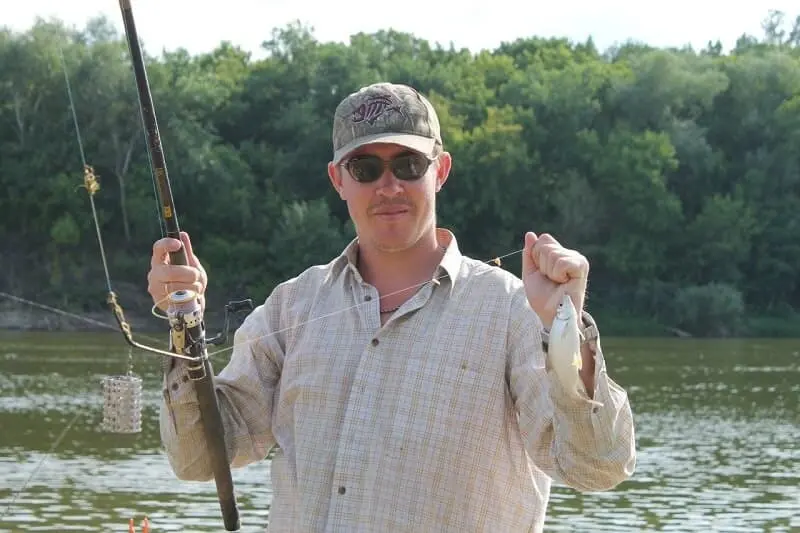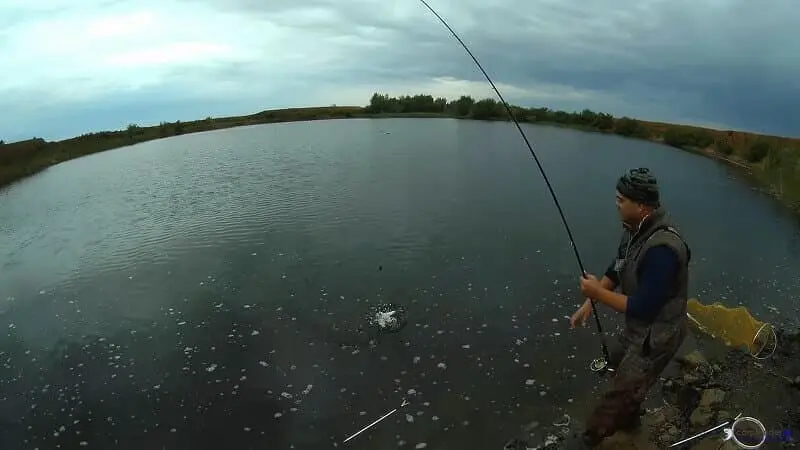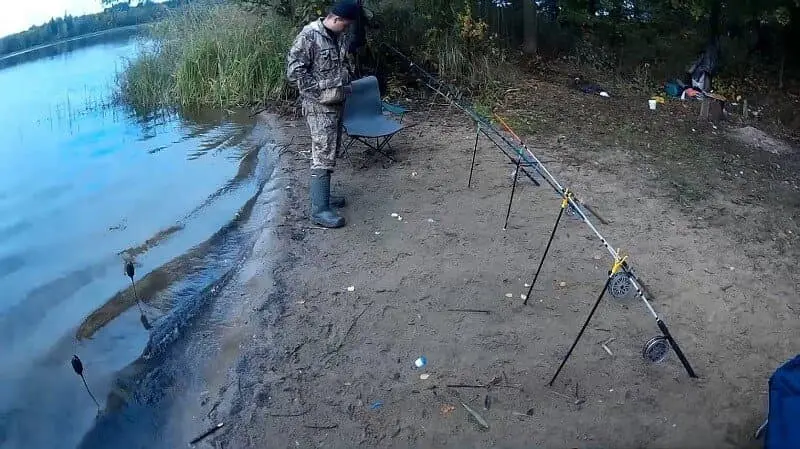Usually the feeder is associated with catching bream, crucian carp, roach. These fish are sedentary and are caught almost all year round. Fishing for sabrefish is rewarding, exciting, but slightly different from traditional fishing.
The sichel is a fish that lives in large flocks and lives in many regions. Even in Siberia you can catch it. Unfortunately, there is not much information about fishing in the Far East, but it is likely that it is there as well.
The appearance of the sabrefish resembles a bleak. It has an elongated body shape and a mouth turned upwards. Its size reaches half a meter in length and weighs about two kilograms. However, the usual prey of an angler is fish weighing no more than a kilogram, and more often – half a kilo. When caught, even a small sabrefish offers stubborn resistance.
The nature of this fish is fundamentally different from both bream and cyprinids. Almost the whole year it stays in the upper and middle layers of the water, and rarely picks up food from the bottom. However, with the advent of winter cold, the sabrefish leaves for their winter habitats, where they gather in large flocks in pools and pits.
Prefers to stay in clean places, not overgrown with aquatic vegetation. Likes sandy and rocky bottom. Usually it is caught in places with a strong current. It lives in flocks, their size depends on the time of year. In a flock there are fish of approximately the same size and age.
A distinctive feature of the sabrefish is the spring and autumn move. For example, fishing on the feeder for sabrefish in September in Astrakhan traditionally gathers a lot of fans and is very fast paced. Of course, in the lower reaches of the Volga, catching fish is not a problem, but in other regions you can also successfully catch it, pulling out a fish every five minutes. The main thing is to find a good place for fishing, choose the right equipment for catching sabrefish on the feeder and find out exactly when the move will be here. It usually lasts about two weeks, so you should not yawn and seize the moment.
Tooling
When catching sabrefish, you need to pay attention to the following points
- Fishing is carried out in the current, often quite strong.
- The bottom is sandy or rocky
- The pace of fishing can be different, from one fish per hour to bites immediately on the cast
- Fishing depth is usually small
Fishing will be carried out with fairly heavy feeders. If the bottom is rocky, the feeder should have a smooth, streamlined top so that it slides out of the rocks and out through the bottom. If it is sandy, small paws on the bottom will help significantly, which will keep it in one place and allow you to work with smaller weights without demolition. However, sometimes, if you are lucky enough to catch without a current, you can put not very large loads.

The rod must be suitable for the weight of the feeder being cast. Usually fishing takes place at a short distance, so it is worth stopping at a feeder for catching sabrefish with a fairly large dough, of medium length. The tip should be chosen coal, rather rigid and durable with a large dough, from three ounces. It is very easy to distinguish the bite of the sabrefish, and there is no need to grind here, she takes it correctly. And the coal will allow you to work even on rifts with jets without problems. Unfortunately, these tips are not very cheap.
A rod reel is usually rarely chosen on purpose. Usually they are content with what is already available. The main thing is that it has enough traction to be able to pull a heavy load over stones without problems. Good coils of sizes from 3000 and above cope with this. If you choose separately for this fishing, you can recommend Daiwa Revros or something similar.
Line or cord? Definitely worth making a choice in favor of the cord. It will show itself well in the current, help in registering bites, smooth out the influence of the jets on the fluctuations of the quiver-type. The fishing line will sail strongly, stretch. When pulling a load with a cord, it is easier to pull it up and pass it above the cartilaginous bottom, where it can get stuck. With a fishing line, its stall and takeoff will be slower. For the same reason, you should not use short picker sticks, even despite the high rate of fishing – it is easier to pluck the load with a medium or long rod from three meters.
Hooks are important for fishing, since not only equipment must be attached to them, but more on that later. They should not have a very large pharynx. The lips of the sichel are thin, and even a small hook can cut through them. However, it should be in the form of a question mark. This is convenient when catching fish with this shape of the mouth and lips, it gives fewer exits, the fish later recognizes the presence of a hook and hooking is more efficient. The forearm should be long enough.
Place of fishing and bait
Feeders are accustomed to feeling the bottom well and making a good starting feed when catching fish. Catching sabrefish breaks this stereotype. Fish move to spawning grounds in flocks and rarely stay in one place for long periods of time to feed. During the periods of summer, when the sichel has spawned, bites are more of a random character. It diverges across the reservoir and there is no point in catching it purposefully – there are more chances to catch other fish.
Here lies another point. Feeder is a tackle that is designed to catch fish from the bottom. However, the sabrefish stays halfway or near the surface. How to catch her with a feeder? You just need to find a good place with a shallow depth, where the jets of water mix. Usually it is on fast rivers. Food in such areas will not last long, and the feeder plays an auxiliary role here – it exudes a large amount of odors that will attract the attention of a passing flock and allow you to catch one or two fish from it.
All options with abundant starting food will not work here, as well as maintaining the same point for fishing. Usually on a river it is important to find the right distance from the bank where the fish pass and fish there. Another thing is in river deltas, where sabrefish gather in large flocks before spawning. There it makes sense to make a starter feed, which will allow the flock to linger, and it will not be washed away by the current in half an hour. And you need to throw it in the place where it was made. But most anglers fish on the rivers.

The feeder should be of medium size. Too small is bad. Food will quickly wash out of it, and you will often have to refill it to fill it again. Big is also bad. It gives an unnecessary waste of food and is strongly carried away by the current. Usually the ideal size of the feeder is when the food is almost completely washed out of it and then the fish bite. It is better to have in stock several feeders with sufficient weight, but of different sizes. When the fish is caught, but there is still food left in the feeder, this is a sign that it is necessary to change it to a smaller size.
They immediately begin to give food when they fall, which allows them to attract fish from long distances and quickly reach the bottom due to their low buoyancy. Chebaryukovka and other feeders with a large wall area will not be very good for sabrefish, as they deliver most of the food to the bottom and leave little of it to fall. You can also recommend the use of springs – feeders, well known in bottom fishing. They are excellent at getting rid of food during the fall. But here they will not keep the bottom perfectly, so it is better to put them in the middle course.
Styrofoam, nozzle and leash
Since fishing takes place far from the bottom layer, the question arises – how to keep the nozzle at a distance from the bottom? Anglers have long found a solution – when catching sabrefish on a hook, along with the bait, they put a small foam ball. Typically, a packaging foam is used that contains a sufficient number of balls. A small one is plucked from it, corresponding to the weight of the nozzle, and first it is planted, fixing it on the eye of the hook, and then the bait. In this case, the nozzle will not lie motionless on the bottom, but will be slightly higher.
The size of the ball should be selected empirically. Often, even if there is fish, it will take in a certain horizon, especially if the depth at the place of fishing is more than one and a half to two meters. It is necessary to select the size of the ball to keep it on this horizon.
This approach requires the use of a nozzle of a strictly defined weight. The sabrefish feeds on insects, bugs, and worms that have fallen into the water during floods. The ideal bait for her is a worm. But in view of the fact that it is quite difficult to pick up a worm of a certain weight in order to observe the fishing horizon, maggots are used. They have an almost perfectly adjusted weight in the brood. It is not known what this is connected with – apparently, with the flock specifics of growth, when they all try to stay on the same level. Three, less often four maggots are planted on the hook after the foam ball.
The leash for such fishing should have an impressive length – from a meter to two. This is necessary in order for the nozzle to float in the water column. Of course, too long a leash will cause the fish, attracted by the smell of the bait, to pass by the bait. Therefore, it is recommended to select the length of the leash at the fishing spot, starting with a long one and gradually shortening it, along the way, picking up the weight of the foam balls, until the fish are biting.

Fishing tactics
She is quite simple. Here, it is not the place of fishing that matters, but the time chosen for fishing. Chekhon is a commercial fish, and you can find out from local fishermen when it goes to spawn. Where its commercial fishing is allowed at this time, it is usually possible to fish on the feeder. For fishing, straight sections of the river with a solid bottom, not overgrown, are selected. Too deep and wide rivers for fishing with a feeder are not suitable – there the sabrefish walks at a great distance from the bottom, and it is easier to achieve success using float gear from a boat or a petty tyrant.
When fishing on a feeder, it is desirable to find a place where the river in the middle has a shallow depth, about two or three meters, and fish a little closer to the shore. After finding a place with a comfortable depth, they throw the tackle and start catching. Passing fish does not linger in one place, so there is no point in looking for where there are a lot of them – you can safely sit all day without going anywhere, it will come by itself. Or he won’t, as you’re lucky. Selecting the weight of the feeder, the length of the leash, the weight of the foam and the number of maggots on the hook, slightly changing the casting distance, they find a combination in which the bites of the sabrefish will go as often as possible.









